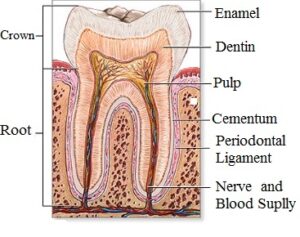
The structure of the tooth includes dentin, pulp and other tissues, blood vessels and nerves embedded in the bony jaw. Above the gum line, the tooth is protected by the hard enamel covering.
While the mouth is a small part of our overall anatomy, it’s filled with many parts and players, all of which work together to help you eat, drink, speak and have a radiant smile. The key players are incisors, canines, premolars, molars, crowns, gum line, root, enamel, dentin and pulp.
The top part of the tooth, and the only part you can normally see. The shape of the crown determines the tooth’s function. For example, front teeth are sharp and chisel-shaped for cutting, while molars have flat surfaces for grinding..
Where the tooth and the gums meet. Without proper brushing and flossing, plaque and tartar can build up at the gumline, leading to gingivitis and gum disease.
The part of the tooth that is embedded in bone. The root makes up about two-thirds of the tooth and holds the tooth in place.
A layer of cementum covers the outside of the root, under the gum line, and holds the tooth in place within the jawbone. Cementum is also as hard as bone.
Enamel, the hardest tissue in the body, covers the dentin and forms the outermost layer of the crown. It enables the tooth to withstand the pressure of chewing and protects it from harmful bacteria and changes in temperature from hot and cold foods. Both the dentin and pulp extend into the root.
Dentin surrounds the pulp. A hard yellow substance, it makes up most of the tooth and is as hard as bone. It’s the dentin that gives teeth their yellowish tint.
The pulp is the innermost portion of the tooth and consists of connective tissue, nerves, and blood vessels, which nourish the tooth. The pulp has two parts – the pulp chamber, which lies in the crown, and the root canal, which is in the root of the tooth. Blood vessels and nerves enter the root through a small hole in its tip and extend through the canal into the pulp chamber.